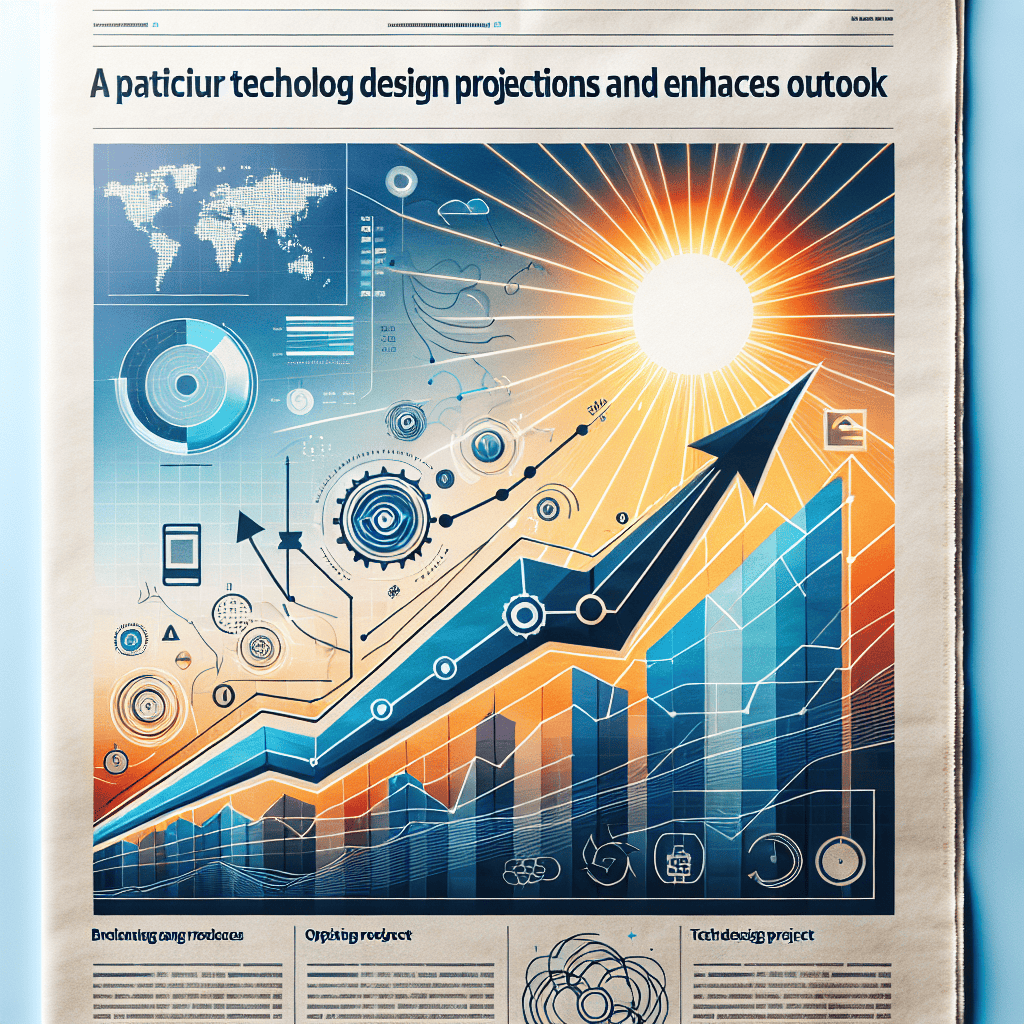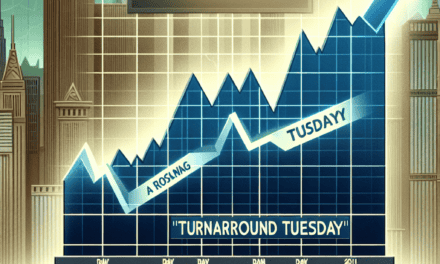“Cadence Design Systems Surpasses Q3 Goals, Elevates Future Outlook!”
Introduction
Cadence Design Systems, a leader in electronic design automation and intelligent system design, has reported impressive financial results for the third quarter, surpassing market expectations. The company’s robust performance is attributed to strong demand for its innovative software solutions and services, which cater to the evolving needs of the semiconductor and electronics industries. As a result of its solid Q3 performance, Cadence has also raised its financial forecast, signaling confidence in its growth trajectory and the continued expansion of its market presence. This upward revision reflects the company’s strategic initiatives and its ability to capitalize on emerging opportunities in the technology sector.
Cadence Design Systems’ Q3 Financial Performance Highlights
Cadence Design Systems, a prominent player in the electronic design automation industry, has recently reported its financial results for the third quarter, surpassing market expectations and subsequently raising its forecast for the remainder of the fiscal year. This performance underscores the company’s robust operational strategies and its ability to adapt to the evolving demands of the technology sector. As the industry continues to experience rapid advancements, Cadence’s strong financial results reflect its strategic positioning and innovative product offerings.
In the third quarter, Cadence reported a significant increase in revenue, driven by strong demand for its software solutions and services. The company’s revenue reached $1.02 billion, marking a notable year-over-year growth. This impressive performance can be attributed to the increasing complexity of semiconductor designs, which has fueled the demand for advanced design tools and solutions. Cadence’s comprehensive suite of products, which includes digital and custom IC design tools, verification solutions, and system design and analysis tools, has positioned it as a leader in addressing these complex design challenges.
Moreover, Cadence’s net income for the quarter also saw a substantial rise, reflecting the company’s operational efficiency and effective cost management strategies. The net income amounted to $260 million, translating to earnings per share of $0.95, which exceeded analysts’ expectations. This financial success is indicative of Cadence’s ability to leverage its technological expertise and capitalize on market opportunities, thereby delivering value to its shareholders.
In addition to its strong financial performance, Cadence has also made significant strides in expanding its customer base and enhancing its product portfolio. The company has continued to invest in research and development, ensuring that its offerings remain at the forefront of technological innovation. This commitment to innovation is evident in the recent launch of several new products and enhancements, which have been well-received by customers and have contributed to the company’s revenue growth.
Furthermore, Cadence’s strategic partnerships and collaborations have played a crucial role in its success. By working closely with leading semiconductor companies and technology firms, Cadence has been able to develop tailored solutions that meet the specific needs of its clients. These partnerships have not only strengthened Cadence’s market position but have also opened up new avenues for growth and expansion.
Looking ahead, Cadence has raised its forecast for the full fiscal year, reflecting its confidence in sustaining its growth momentum. The company now expects its annual revenue to be in the range of $3.95 billion to $4.05 billion, with earnings per share projected to be between $3.70 and $3.80. This optimistic outlook is supported by the continued demand for Cadence’s solutions, as well as the company’s strategic initiatives aimed at capturing emerging opportunities in areas such as artificial intelligence, machine learning, and 5G technology.
In conclusion, Cadence Design Systems’ exceptional third-quarter performance highlights its strong market position and its ability to navigate the dynamic landscape of the technology industry. By exceeding expectations and raising its forecast, Cadence has demonstrated its resilience and adaptability, positioning itself for sustained growth in the future. As the company continues to innovate and expand its offerings, it remains well-equipped to meet the evolving needs of its customers and deliver long-term value to its stakeholders.
Key Factors Behind Cadence’s Q3 Success
Cadence Design Systems has recently reported its financial results for the third quarter, surpassing market expectations and subsequently raising its forecast for the remainder of the fiscal year. This impressive performance can be attributed to several key factors that have collectively contributed to the company’s success. As a leader in electronic design automation (EDA) software, Cadence has consistently demonstrated its ability to innovate and adapt to the evolving needs of the semiconductor industry. In this context, the company’s strategic initiatives, robust product portfolio, and strong customer relationships have played pivotal roles in driving its Q3 achievements.
To begin with, Cadence’s strategic focus on expanding its product offerings has been instrumental in capturing a larger market share. The company has invested significantly in research and development, resulting in the introduction of cutting-edge solutions that address the complex challenges faced by semiconductor designers. By leveraging advanced technologies such as artificial intelligence and machine learning, Cadence has enhanced the capabilities of its EDA tools, enabling customers to achieve higher levels of efficiency and performance in their design processes. This commitment to innovation has not only strengthened Cadence’s competitive position but also attracted new customers seeking state-of-the-art solutions.
Moreover, Cadence’s robust product portfolio has been a key driver of its Q3 success. The company’s comprehensive suite of EDA tools and IP solutions caters to a wide range of applications, from digital and analog design to system-level verification and implementation. This versatility allows Cadence to serve a diverse customer base, including leading semiconductor companies, system integrators, and emerging startups. By offering a holistic set of solutions, Cadence has positioned itself as a one-stop-shop for design automation needs, thereby increasing its appeal to customers looking for integrated and efficient design workflows.
In addition to its product offerings, Cadence’s strong customer relationships have been a cornerstone of its success. The company has cultivated long-standing partnerships with industry leaders, enabling it to gain valuable insights into customer requirements and emerging trends. This customer-centric approach has allowed Cadence to tailor its solutions to meet specific needs, thereby enhancing customer satisfaction and loyalty. Furthermore, Cadence’s commitment to providing exceptional support and services has reinforced its reputation as a trusted partner in the semiconductor ecosystem.
Another factor contributing to Cadence’s Q3 performance is its strategic expansion into high-growth markets. Recognizing the increasing demand for semiconductor solutions in areas such as automotive, 5G, and artificial intelligence, Cadence has proactively targeted these sectors with specialized offerings. By aligning its product development efforts with the needs of these burgeoning markets, Cadence has successfully captured new business opportunities and driven revenue growth.
Finally, Cadence’s financial discipline and operational efficiency have also played a role in its Q3 success. The company has maintained a strong focus on cost management and resource optimization, ensuring that it can deliver value to shareholders while continuing to invest in strategic initiatives. This balanced approach has enabled Cadence to achieve sustainable growth and profitability, even in the face of macroeconomic uncertainties.
In conclusion, Cadence Design Systems’ impressive Q3 performance is the result of a combination of strategic initiatives, innovative product offerings, strong customer relationships, market expansion efforts, and financial discipline. As the company looks to the future, it remains well-positioned to capitalize on emerging opportunities and continue its trajectory of success in the dynamic semiconductor industry.
How Cadence Design Systems is Shaping the Future of Design Automation
Cadence Design Systems, a leader in electronic design automation (EDA) software, has recently surpassed market expectations for its third-quarter performance, further solidifying its position as a pivotal player in the design automation industry. This achievement not only highlights the company’s robust operational strategies but also underscores its commitment to innovation and excellence in a rapidly evolving technological landscape. As the demand for sophisticated design tools continues to grow, Cadence’s ability to exceed financial forecasts is a testament to its strategic foresight and adaptability.
The company’s impressive third-quarter results can be attributed to several key factors. Firstly, Cadence has consistently invested in research and development, ensuring that its product offerings remain at the cutting edge of technology. By focusing on innovation, Cadence has been able to provide its clients with advanced tools that enhance productivity and efficiency in the design process. This commitment to technological advancement has enabled the company to maintain a competitive edge in the EDA market, attracting a diverse range of clients from various sectors, including semiconductor, automotive, and consumer electronics.
Moreover, Cadence’s strategic partnerships and collaborations have played a crucial role in its success. By aligning with industry leaders and forming alliances with key players, Cadence has been able to expand its reach and influence within the design automation ecosystem. These partnerships have facilitated the integration of Cadence’s tools with other technologies, creating a seamless experience for users and fostering a collaborative environment that drives innovation. As a result, Cadence has been able to offer comprehensive solutions that address the complex challenges faced by designers and engineers today.
In addition to its focus on innovation and collaboration, Cadence has also demonstrated a keen understanding of market trends and customer needs. By closely monitoring industry developments and anticipating future demands, the company has been able to tailor its offerings to meet the evolving requirements of its clients. This customer-centric approach has not only strengthened Cadence’s relationships with existing clients but has also attracted new customers seeking reliable and cutting-edge design solutions.
Furthermore, Cadence’s commitment to sustainability and ethical practices has resonated with clients and stakeholders alike. As environmental concerns continue to shape business practices across industries, Cadence has taken proactive steps to ensure that its operations and products align with sustainable principles. By prioritizing energy efficiency and reducing the environmental impact of its tools, Cadence has positioned itself as a responsible and forward-thinking leader in the design automation space.
Looking ahead, Cadence’s strong third-quarter performance and optimistic forecast signal a promising future for the company. As it continues to innovate and adapt to the changing needs of the industry, Cadence is well-positioned to shape the future of design automation. By leveraging its expertise, strategic partnerships, and commitment to sustainability, Cadence is poised to drive significant advancements in the field, ultimately enabling designers and engineers to create more efficient, reliable, and sustainable products.
In conclusion, Cadence Design Systems’ ability to exceed expectations and boost its forecast reflects its unwavering dedication to excellence and innovation. As the company continues to navigate the complexities of the design automation industry, its strategic initiatives and forward-thinking approach will undoubtedly play a crucial role in shaping the future of design automation, benefiting not only its clients but also the broader technological landscape.
The Impact of Cadence’s Q3 Results on the Stock Market

Cadence Design Systems, a prominent player in the electronic design automation industry, recently announced its third-quarter financial results, surpassing market expectations and subsequently raising its forecast for the remainder of the fiscal year. This development has had a notable impact on the stock market, as investors and analysts alike reassess the company’s potential for growth and profitability. The impressive performance in Q3 can be attributed to several key factors, including robust demand for Cadence’s innovative software solutions and strategic partnerships that have expanded its market reach.
To begin with, Cadence’s strong Q3 results were driven by increased adoption of its cutting-edge design tools, which are essential for the development of complex semiconductor devices. As the demand for advanced electronics continues to rise, fueled by trends such as artificial intelligence, 5G, and the Internet of Things, Cadence has positioned itself as a critical enabler of technological innovation. This has allowed the company to capture a larger share of the market, thereby boosting its revenue and profitability. Furthermore, Cadence’s commitment to research and development has resulted in a steady stream of new products and enhancements, keeping it ahead of competitors and maintaining its reputation as a leader in the industry.
In addition to product innovation, Cadence’s strategic alliances have played a significant role in its recent success. By collaborating with key players in the semiconductor and electronics sectors, Cadence has been able to integrate its solutions more deeply into the design and manufacturing processes of its partners. These partnerships not only enhance the value proposition of Cadence’s offerings but also provide access to new customer segments and geographies. As a result, the company has been able to achieve a more diversified revenue stream, reducing its reliance on any single market or client.
The positive financial performance reported by Cadence has had a ripple effect on the stock market, with the company’s shares experiencing a notable uptick following the announcement. Investors have responded favorably to the upward revision of Cadence’s full-year forecast, interpreting it as a sign of confidence in the company’s future prospects. This optimism is further supported by the broader industry trends that continue to drive demand for electronic design automation tools. As a result, Cadence’s stock has become an attractive option for investors seeking exposure to the growing technology sector.
Moreover, the strong Q3 results have prompted analysts to revise their ratings and price targets for Cadence’s stock. Many have highlighted the company’s solid execution and strategic positioning as key factors that will support sustained growth in the coming quarters. This has contributed to increased investor interest and trading volume, further amplifying the impact of Cadence’s performance on the stock market.
In conclusion, Cadence Design Systems’ impressive third-quarter results and subsequent forecast revision have had a significant impact on the stock market, underscoring the company’s strong position in the electronic design automation industry. Through a combination of innovative products, strategic partnerships, and favorable market conditions, Cadence has demonstrated its ability to capitalize on emerging opportunities and deliver value to its shareholders. As the company continues to execute on its growth strategy, it is likely to remain a key player in the technology sector, attracting the attention of investors and analysts alike.
Cadence’s Strategic Moves That Led to Exceeding Q3 Expectations
Cadence Design Systems, a prominent player in the electronic design automation industry, has recently reported financial results that surpassed expectations for the third quarter, subsequently raising its forecast for the remainder of the fiscal year. This achievement can be attributed to a series of strategic moves that have positioned the company favorably in a competitive market. By examining these strategies, one can gain insight into how Cadence has managed to exceed its Q3 expectations and set a positive trajectory for future growth.
To begin with, Cadence’s commitment to innovation has been a cornerstone of its success. The company has consistently invested in research and development, ensuring that its product offerings remain at the cutting edge of technology. This focus on innovation has allowed Cadence to introduce new tools and solutions that address the evolving needs of its customers, particularly in areas such as artificial intelligence, machine learning, and 5G technology. By staying ahead of technological trends, Cadence has been able to capture a larger share of the market, thereby driving revenue growth.
In addition to its emphasis on innovation, Cadence has also pursued strategic partnerships and acquisitions that have bolstered its capabilities and expanded its market reach. For instance, the acquisition of smaller, specialized firms has enabled Cadence to integrate new technologies and expertise into its portfolio, enhancing its ability to offer comprehensive solutions to its clients. These acquisitions have not only strengthened Cadence’s product lineup but have also opened up new revenue streams, contributing to the company’s impressive financial performance in the third quarter.
Moreover, Cadence’s focus on customer-centricity has played a significant role in its success. By prioritizing customer needs and fostering strong relationships, Cadence has been able to build a loyal client base that values the company’s commitment to delivering high-quality solutions. This customer-centric approach has been instrumental in driving repeat business and securing long-term contracts, which have provided a stable foundation for Cadence’s financial growth.
Furthermore, Cadence’s strategic expansion into emerging markets has been a key factor in its ability to exceed Q3 expectations. Recognizing the potential for growth in regions such as Asia-Pacific and Latin America, Cadence has made concerted efforts to establish a presence in these areas. By tailoring its offerings to meet the specific needs of these markets, Cadence has been able to tap into new customer segments and drive additional revenue. This geographic diversification has not only contributed to the company’s strong performance in the third quarter but has also positioned it well for sustained growth in the future.
In light of these strategic moves, Cadence’s decision to raise its forecast for the remainder of the fiscal year appears well-founded. The company’s ability to innovate, form strategic partnerships, prioritize customer needs, and expand into emerging markets has created a robust foundation for continued success. As Cadence continues to execute on its strategic initiatives, it is likely to maintain its competitive edge and deliver strong financial results in the quarters to come. Consequently, investors and stakeholders can remain optimistic about Cadence’s future prospects, as the company continues to navigate the dynamic landscape of the electronic design automation industry with agility and foresight.
Analyzing Cadence’s Updated Forecast and Market Implications
Cadence Design Systems, a prominent player in the electronic design automation (EDA) industry, has recently reported its third-quarter financial results, surpassing market expectations and subsequently raising its forecast for the upcoming quarters. This development has garnered significant attention from investors and industry analysts alike, as it not only reflects the company’s robust performance but also signals potential shifts in the broader market landscape.
To begin with, Cadence’s third-quarter results were marked by a notable increase in both revenue and profit margins. The company reported a revenue of $1.02 billion, which represents a substantial year-over-year growth. This impressive performance can be attributed to the increasing demand for advanced semiconductor design tools and solutions, driven by the rapid advancements in technology sectors such as artificial intelligence, 5G, and automotive electronics. Furthermore, Cadence’s strategic investments in research and development have enabled it to maintain a competitive edge, offering innovative solutions that cater to the evolving needs of its clientele.
In light of these strong results, Cadence has revised its financial forecast for the remainder of the fiscal year. The company now anticipates higher revenue and earnings per share than previously projected, reflecting its confidence in sustaining the current growth trajectory. This optimistic outlook is underpinned by several factors, including a robust pipeline of new projects, strategic partnerships, and an expanding customer base. Additionally, Cadence’s focus on diversifying its product portfolio and enhancing its cloud-based offerings is expected to further bolster its market position.
The implications of Cadence’s updated forecast extend beyond the company itself, as it may influence investor sentiment and market dynamics within the EDA industry. For instance, Cadence’s strong performance could prompt investors to reassess their positions in other EDA companies, potentially leading to increased interest and investment in the sector. Moreover, the company’s success may encourage competitors to intensify their efforts in innovation and customer engagement, fostering a more dynamic and competitive market environment.
Furthermore, Cadence’s achievements highlight the growing importance of EDA tools in the semiconductor industry, which is experiencing unprecedented demand due to the proliferation of digital technologies. As companies across various sectors seek to develop more sophisticated and efficient electronic devices, the need for advanced design solutions is becoming increasingly critical. Consequently, Cadence’s ability to deliver cutting-edge tools and services positions it well to capitalize on these emerging opportunities.
In conclusion, Cadence Design Systems’ exceptional third-quarter performance and revised forecast underscore its strong market position and growth potential. The company’s strategic initiatives, coupled with favorable industry trends, have enabled it to exceed expectations and set a positive tone for the future. As the EDA industry continues to evolve, Cadence’s success serves as a testament to the critical role of innovation and adaptability in navigating the complexities of the modern technological landscape. Moving forward, it will be essential for Cadence to maintain its momentum by continuing to invest in research and development, expanding its product offerings, and strengthening its customer relationships. By doing so, the company can not only sustain its competitive advantage but also contribute to shaping the future of electronic design automation.
The Role of Innovation in Cadence’s Continued Growth
Cadence Design Systems has once again demonstrated its prowess in the electronic design automation (EDA) industry by exceeding expectations in the third quarter and subsequently raising its forecast for the future. This achievement underscores the pivotal role that innovation plays in the company’s sustained growth and success. As the demand for sophisticated electronic devices continues to surge, Cadence’s commitment to innovation has positioned it as a leader in providing cutting-edge solutions that meet the evolving needs of its clients.
One of the key factors contributing to Cadence’s impressive performance is its strategic focus on research and development. By investing heavily in R&D, the company has been able to consistently introduce new technologies and tools that enhance the design and verification processes for electronic systems. This commitment to innovation not only strengthens Cadence’s product portfolio but also solidifies its reputation as a forward-thinking leader in the EDA industry. Moreover, the company’s ability to anticipate market trends and adapt its offerings accordingly has been instrumental in maintaining its competitive edge.
In addition to its robust R&D efforts, Cadence’s collaborative approach with its clients has played a significant role in its continued growth. By working closely with customers, Cadence gains valuable insights into their specific challenges and requirements. This collaborative dynamic enables the company to tailor its solutions to better address the unique needs of each client, thereby fostering long-term partnerships and driving customer satisfaction. Furthermore, this customer-centric approach has allowed Cadence to stay ahead of the curve by developing solutions that are not only innovative but also highly relevant to the market.
Transitioning to the broader industry landscape, the increasing complexity of electronic systems has created a pressing need for more advanced design tools. Cadence has adeptly responded to this demand by leveraging its innovative capabilities to develop solutions that streamline the design process and improve efficiency. For instance, the company’s advancements in artificial intelligence and machine learning have enabled the automation of various design tasks, significantly reducing the time and effort required to bring new products to market. This not only benefits Cadence’s clients by accelerating their development cycles but also enhances the company’s value proposition in a competitive industry.
Moreover, Cadence’s strategic acquisitions have further bolstered its innovation-driven growth. By acquiring companies with complementary technologies and expertise, Cadence has been able to expand its capabilities and enter new markets. These acquisitions not only enhance the company’s technological offerings but also provide access to new customer bases and revenue streams. As a result, Cadence is well-positioned to capitalize on emerging opportunities and continue its trajectory of growth.
Looking ahead, Cadence’s raised forecast reflects its confidence in the ongoing demand for its innovative solutions. As the EDA industry continues to evolve, the company’s unwavering commitment to innovation will undoubtedly remain a cornerstone of its strategy. By continuously pushing the boundaries of what is possible in electronic design, Cadence is poised to maintain its leadership position and drive further growth in the years to come. In conclusion, the role of innovation in Cadence’s continued success cannot be overstated, as it serves as the foundation upon which the company builds its future achievements.
Q&A
1. **What company is the focus of the report?**
Cadence Design Systems.
2. **What financial period does the report cover?**
The report covers the third quarter (Q3).
3. **Did Cadence Design Systems meet, exceed, or fall short of expectations in Q3?**
Cadence Design Systems exceeded expectations in Q3.
4. **What action did Cadence Design Systems take regarding its future financial outlook?**
Cadence Design Systems boosted its forecast.
5. **What is the primary industry or sector in which Cadence Design Systems operates?**
Cadence Design Systems operates in the electronic design automation (EDA) industry.
6. **What might be a reason for Cadence Design Systems’ strong performance in Q3?**
Possible reasons could include strong demand for their software solutions, successful product launches, or effective cost management.
7. **How might investors react to the news of Cadence Design Systems exceeding expectations and boosting its forecast?**
Investors might react positively, potentially leading to an increase in the company’s stock price.
Conclusion
Cadence Design Systems reported strong financial results for the third quarter, surpassing market expectations. The company’s robust performance was driven by increased demand for its electronic design automation software and services, reflecting its strategic focus on innovation and customer engagement. As a result of this positive momentum, Cadence has raised its financial forecast for the upcoming period, signaling confidence in continued growth and market leadership. This upward revision in guidance underscores the company’s solid execution and its ability to capitalize on industry trends, positioning it well for sustained success in the competitive technology landscape.





